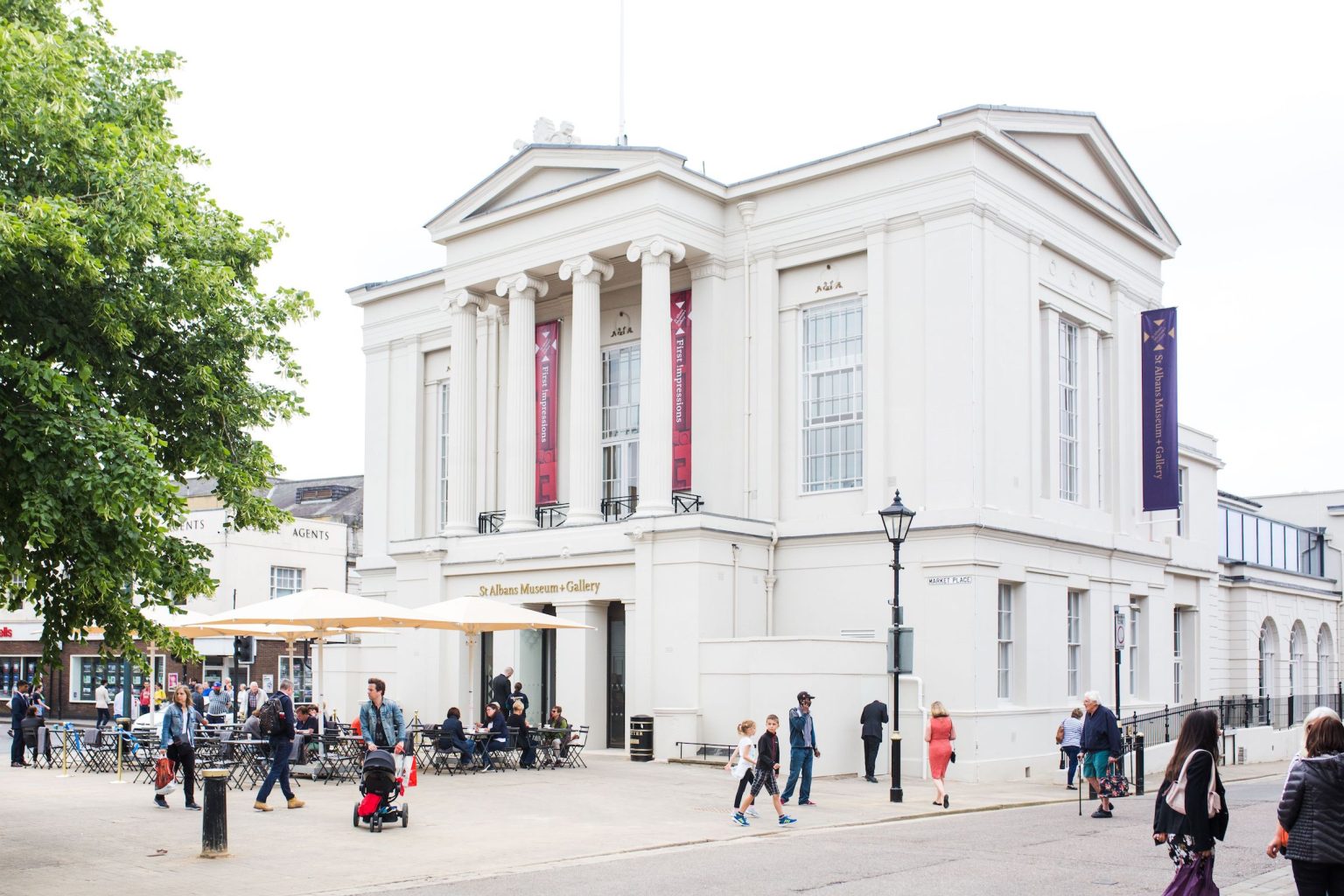Forget the likes of York, Bath, and Oxford- take the path less trodden in 2025 and make haste to the historic Cathedral city of St Albans where you’ll discover a delectable slice of Old England.
If you like British history, St Albans in Hertfordshire is a must-visit. Situated a swift 20-minute train ride from London St Pancras, it’s an accessible day trip destination for anyone visiting the UK’s capital.
Built on the ancient Roman town of Verulamium and home to Britain’s first Saint- feel like you’re stepping back in time when you meander along its picturesque, cobbled streets, visit its 1,000-year-old market, climb the medieval Clock Tower and marvel at its stunning Cathedral.
Yet, with trendy independent boutiques, award-winning food and drink establishments, vibrant street festivals, abundant green spaces and out of the ordinary music, art and culture venues, St Albans offers the perfect blend of the old and new.
A slice of old England …
The Roman Origins of St Albans
The Roman city of Verulamium, on which modern day St Albans was built, thrived from around AD 50 to AD 400-450, during which time it covered a maximum area of about 125 acres, and included a forum, basilica and theatre, the latter of which survives to the present day. Evidence of the Roman occupation can also be seen in the city walls and hypocaust in situ under a mosaic floor in Verulamium Park, and another mosaic can be found hidden away beneath the floor of the foyer at the Alban Arena entertainment venue.
Thought to be the only example of its kind in Britain, the Roman Theatre of Verulamium was built in the year AD 140 and the arena would have been used for religious processions, dancing, armed combat, and wild beast shows. Today, culture lovers can enjoy an evening watching productions by theatre company, OVO- the open-air theatre’s unique al fresco surroundings really add something to the already exciting professional performance on stage and proves that live entertainment has been enjoyed in St Albans for thousands of years.
Become fully immersed in the wonders of Roman life with a visit to Verulamium Musuem, Tripadvisor Traveller’s Choice winner 2024 (in the top 10% of sites reviewed by visitors, worldwide). Explore recreated Roman rooms, discover ancient treasures, and admire the craftsmanship of intricate large-scale mosaics on display.
Medieval Musings
Built in 1405, the Clock Tower is now the only surviving medieval town belfry in England, and over the centuries has been a shop and a government telegraph station during the Napoleonic wars. Gabriel, the Tower’s original one ton bell, remains in place, and in past times would have sounded the Angelus and the evening Curfew. It would have also rung out an alarm in case of “fire or fray”, such as at the First Battle of St Albans in 1455. Today’s visitors can climb the 93 steps to the top and enjoy magnificent views of the historic city, the cathedral, and surrounding countryside.
St Albans Cathedral has an extensive collection of medieval wall paintings and is the oldest site of continuous Christian worship in Britain. Step inside and you’ll find the Shrine of St Alban, Britain’s first saint and who the city was named after, which has been a focal point for visitors and pilgrims alike for over 1,700 years. And at 85 metre long, it has the longest nave of any cathedral in England.
St Albans Cathedral is the jewel of the city but there are many beautiful and historic churches to visit, each with its own fascinating story to tell. Including St Peter’s Church which has long been a place of hospitality as one of the city’s ancient gateway churches. It’s stunning Rose Window at the West End of the building was first installed in the 1890s and is utterly mesmerizing.
A thousand-year-old market
The award-winning St Albans Charter Market was first established in around 860 AD by the sixth abbot of St Albans Abbey to generate additional income, and in 1553 a Royal Charter issued by Edward VI formalised its status, specifying the market days as Wednesday and Saturday. St Albans remains a charter market to this day, attracting traders and shoppers from across the region is winner of the prestigious national award, ‘Best Large Outdoor Market in Britain 2024’.
Quirky Streets
St Albans was the first major city on the old Roman road of Watling Street for travellers heading north from London and it has continued to draw in travellers to this day. Many buildings date from the 16th and 17th centuries and there is still a mix of Georgian, Tudor, Neo-classical and Victorian architecture. French Row in the city centre dates back to at least 1335, and according to local legend King John of France was accommodated in an inn which existed on the site of the current Snug pub.
Picturesque Fishpool Street is another go-to spot for a leisurely wander and to imagine times-gone-by. It’s where, in around 1381, local rebels impacted by crippling taxes and the Black Death, stormed the Abbey Gateway and freed all local prisoners. But the rebellion was not to last, and King Richard II personally came to the town for the trial of the ringleaders, who were all found guilty and hanged. The uprising of the “common” people of St Albans was to become known as the Peasants’ Revolt.
Town Hall Courtroom is now a café
Located in the Georgian Grade II* listed former town hall building of St Albans Museum + Gallery, is a café set in the old octagonal courtroom complete with judge’s chair, dock and cells below. The space ran as a court between 1831 and 1966. Venture down to the cells and soak up the eerie atmosphere before heading back up to the café for a delicious pastry, tasty lunch or refreshments. Make sure to explore the elegant Georgian Assembly Room with its grand crystal chandeliers, it’s very Bridgerton-esque!
Charles Dickens
Although the celebrated Victorian author’s ninth novel, Bleak House, was written while he was staying at a Kent mansion, research suggests he visited St Albans during his stays at Knebworth House, and took the name of the book after a house at the crossroads of Gombards/Normandy Road and Folly Lane.
Frederic Kitton established himself as the pre-eminent expert on the life of Charles Dickens publishing a plethora of books and illustrations on the writer. Kitton moved to St Albans in about 1883 after passing through it on a walking tour and being impressed by its picturesque views. An early advocate of the heritage movement, Kitton was responsible for helping to preserve many of St Albans’ historic buildings, including The Gables, which was saved from demolition in 1899 by its owner Jesse Boot of Boots, the Chemists, and still stands today with iconic status in the city.
Home of The Ryder Cup
Samuel Ryder is remembered as one of St Albans’ most notable citizens, a successful and caring businessman, a profound churchman and philanthropist, a progressive politician and also the founder of the Ryder Cup, one of the most prestigious international golfing tournaments.
A member of Verulam Golf Club, Ryder’s idea for a match between teams of professionals from Great Britain and the USA, served as the impetus for the first official match for the Ryder Cup in 1927. For enthusiasts, a visit to Verulam Golf Club is a ‘must’ with incredible memorabilia including a striking portrait of Samuel Ryder with the Deed of Trust for the Ryder Cup in his hand, a colourful gallery of golfing legends and an impressive range of vintage golf clubs. The Clubhouse is open daily from 9am until dark if visitors simply wish to relax with a drink or to dine with stunning views.
Golf fans and history buffs can also enjoy a stay in a Grade II listed building, previously the head office of Ryder’s ‘penny packet’ seed company, the very place the businessman would have also made the idea of the Ryder Cup come to life. Now a boutique hotel, The Samuel Ryder Hotel St Albans, Tapestry Collection by Hilton offers 60 stylish rooms in the heart of the city. Just next door is Ryder’s Exhibition Hall- a beautiful Grade II listed art deco building where Ryder displayed his seeds and plants.
Pubs Galore
Home to the Campaign for Real Ale, beer is woven into the fabric of St Albans. From early pilgrims visiting the Shrine of St Alban to passengers on northbound stagecoach routes up from London, the city has always been full of inns that would provide refreshments to weary travellers. A particular favourite, Ye Olde Fighting Cocks, is reputed to be the oldest pub in the country.
St Albans has a pub to suit everyone. Try The Boot, another historic inn where real ale and craft beers are often accompanied by open-mic entertainment. The Saint & Sinner is a new addition to the St Albans pub scene, but contributes a vibrant atmosphere, delicious cocktails, and a fantastic outdoor space. Dylans at the Kings Arms is the recipient of countless accolades for its top-quality food and drink.
Fascinating blue plaques to hunt for
Famous former residents have been commemorated with blue plaques on buildings associated with their lives. The initiative, set up by Blue Plaques St Albans, resembles the well-known scheme run by English Heritage. Find plaques of world-famous theoretical physicist, cosmologist and author Stephen Hawking, St Albans’ third lady Mayor Elsie Toms, and pre-Raphaelite painter ER “Ted” Hughes, plus many more.
“A great deal of the charm of St Albans and a reason why people visit the city is because of its blend of the old and the new. St Albans has inherited a rich urban landscape full of buildings of many vintages: from the timber-framed vernacular of the late-medieval and early modern periods to Georgian mansions, streets of Victorian dwellings and 20th century estates.” St Albans and Hertfordshire Architectural Archaeological Society
Easily accessible by plane (Luton airport) by road (M25, M1 and A1(M)) and just 20 miles and 20 minutes by train from London St Pancras.
Find your St Albans at www.EnjoyStAlbans.com @enjoystalbans
Where to Stay…
Accommodation ranges from small and intimate bed and breakfasts to large hotels including the White Hart Hotel & Restaurant and the Hilton’s Samuel Ryder Hotel, both in the centre of town, the stunning country style Manor hotel, St Michaels Manor, luxurious Sopwell House and the Victorian Grade II listed Torrington Hall.
About St Albans
- St Albans is a must-visit UK destination. A historic gem of an English Cathedral City, the stunning cathedral is the oldest place of continuous Christian worship in the country
- The city’s colourful history and heritage can be seen in the beautiful medieval architecture and picturesque buildings that look spectacular all year round
- Formerly known as “Verulamium”, this is a city packed with Roman history with high quality roman artifacts and well-preserved mosaic flooring in a museum within walking distance from city centre
- A premier shopping destination outside London, St Albans is home to an array of innovative independent retailers and big brand names
- The city is a ‘Mini London’ for foodies with a plethora of old pubs, award winning restaurants and top chefs- plus Britain’s oldest pub, Ye Olde Fighting Cocks
- Enjoy lots of green, open spaces and parks- making St Albans a family-friendly destination
- Easily accessible by road and train, St Albans is conveniently located close to the M25, M1 and A1(M) and just 20 miles and 20 minutes by train from London.









